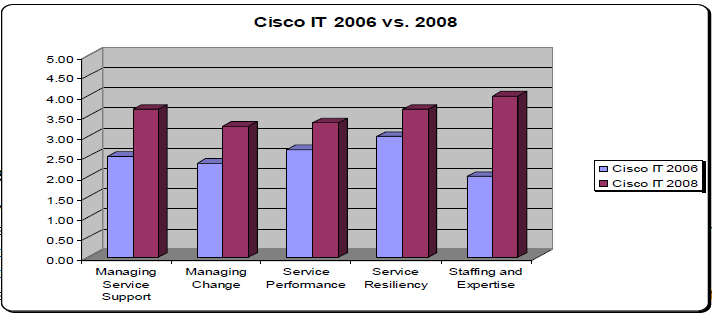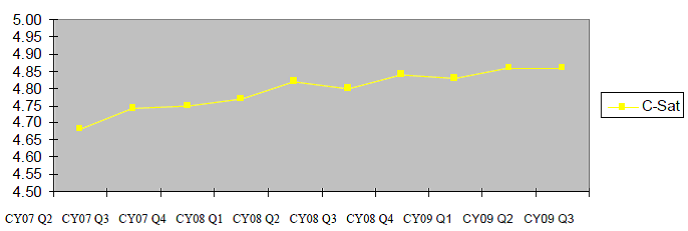Introduction
Organizations experience various changes throughout their lifecycles. Some firms may not recover from such events, which result in massive losses, but other firms usually restructure and continue with their business activities.
This research focuses on Cisco Systems, General Motors, and Avon. It shows how these companies were able to restructure their operations and get back to business.
Cisco Systems
IT firms of today need to optimize their services and resources while focusing on cost reduction and improving on productivity. Cisco implemented a lifecycle methodology during its restructuring efforts. The company needed to make its processes responsive and efficient. Cisco changed from using a traditional organizational model to a new lifecycle-based model. As a result, the company improved its operations across five different domains.
Previously, Cisco relied on a traditional silo-based organizational structure (Cisco Systems, Inc., 2008). Employees had to handle all aspects of operational and implementation works.
Thus, they had to drop some operational duties in order to facilitate deployment. The traditional approach created duplication of work and effort throughout the organization. However, employees were not aware of the role and effort duplication within Cisco. The regional voice and network teams were in charge of implementation and operations. These teams worked with over 300 customers.
They had to evaluate and manage support services, change, service performance, service resiliency, and staff and expertise. As a result of a tremendous growth, the company could not cope with these roles and technology evolution. Cisco’s existing resources could not accommodate growing needs of customers. Such needs put pressure on available resources to the limit. The company needed a change because of deteriorating services.
Cisco had to change from the traditional IT-based approach to a modern approach. Thus, the firm had to restructure it processes and operations in order to accommodate work and effort duplication and accommodate the growing demands from customers. Cisco had to consolidate and simplify its operations. In addition, it had to introduce effective communication and collaboration strategies. This change had to affect the global operations of the company.
Cisco organizational structure solved its business challenges. The new lifecycle business model improved business operations and customer service. The restructuring affected more than 400 workers in different business units. The initiative led to several positive changes in the company. Different teams can now spend their time on training and mentoring new employees. Cisco created a ‘focus area’ to cater for specific needs in different service areas.
The team proactively focused on operations using a developed strategy that focused on similar activities. Different business units improved collaboration and communication. This has facilitated ‘horizontal processes’, which have facilitated feedback processes within the company. Moreover, the company has relied on regular communication and reinforcement strategies during staff meetings to analyze performance metrics and link them with the reward and recognition system.

Figure 1: Cisco change in operations after restructuring
The company used its restructuring strategy to focus on new ways of improving operational efficiency by focusing on support services. Cisco has been able to improve its customer services because of increased focus on customer cases.

Figure 2: Cisco’s rise in customer satisfaction after restructuring
The company has embarked on improving its existing structures to accommodate growth. Moreover, the current IT firm can respond appropriately to changes and demands in the IT industry. The company believes that as it grows, it would be able to respond to customers’ needs with improved services.
The company believes that the “lifecycle methodology laid the groundwork for structuring efforts for improving effectiveness and productivity” (Cisco Systems, Inc., 2008). The company wants its right staff to focus on business improvement through the evolutionary framework of the lifecycle methodology.
General Motors (GM)
The automotive industry is significant in the US economy. The industry leads in job creation and consumption of raw materials like plastic, glass, iron, steel, aluminum, and electronics (General Motors Corporation, 2009). Thus, changes in the automobile industry in the US have massive impacts.
From 2008, the company had to cope with the worst financial crisis and credit market in the history of the world. There were significant changes in the American and the world economy. As a result, the sales of new vehicles declined quickly. General Motor’s experienced a rapid decline in revenues.
Moreover, this decline enhanced the speculation about a possible bankruptcy of the company. The company consumed its liquidity and faced bankruptcy. GM resorted to Federal assistance in order to improve normal operations and market conditions. It required $18 billion in assistance for restructuring and improving operations (General Motors Corporation, 2009). The company expected to start repayment of the Federal loan from 2011. GM’s restructuring strategies involved the following approaches.
First, GM wanted to embark on dramatic changes in its product portfolio. The company wanted to launch 22 new vehicles between 2009 and 2012, which would be fuel-efficient and crossovers. Second, GM restructuring strategy would involve the introduction of new products that would be fully compliant with the 2007 Energy Independence and Security Act.
In addition, GM also wanted to invest in varieties of advanced propulsion technologies, improve its existing power trains, develop small displacement engines, improve automatic transmission, and develop light and hybrid vehicles. Third, the company wanted to streamline its operations, reduce brands, nameplates, and dealerships in order to concentrate its available resources on growth strategies in profitable areas.
Fourth, the company also wanted to introduce “full labor cost competitiveness with foreign manufacturers in the US by no later than 2012” (General Motors Corporation, 2009). Fifth, GM had intended to improve manufacturing efficiency and reduce costs by improving productivity and reducing the number of employees. The company has consolidated its manufacturing facilities across various regions.
This has allowed the company to achieve high productivity and flexibility in manufacturing processes. This would ensure that the company enhances production in the following years. In fact, GM has made significant improvement in vehicle manufacturing. It also embarked on a global integrated strategy in its major manufacturing plants.
This was a strategy to introduce general lean processes and principles in manufacturing. The company restructuring efforts would result in flexible production in all major assembly locations, which handle various vehicles. Finally, GM also intended to restructure its balance sheet and boost its liquidity through Federal fiscal aid. The overall aim of these restructuring strategies and financial aid were to restore GM to operations, boost production, and restore profitability.
GM had to revamp its dealerships because they had served the traditional markets. However, they needed improvement for excellent customer care and convenience. The company had to change in order to match competitive strategies. GM had to recruit dealers in good locations for business in which it could derive maximum revenues.
Avon
The company manufacturers and sales beauty and other related products. Avon has worldwide operations through its direct-selling channel strategy. The company has more than 42,000 employees. Avon has recorded financial growths since 2009 because of its restructuring efforts. It also recorded an increase in operating profit of $1,073.1 million. This represented an increment of 6.7 percent compared to the year 2009.
The company has experienced intense competition in the cosmetic industry. Since 2005, Avon had not been performing well (Todé, 2005). Consequently, the company embarked on a restructuring effort that had significant consequences.
Avon restructuring included substantial downsizing of its workforce according the Andrea Jung, the CEO. In 2005, the CEO identified a four-point restructuring strategy that focused on increasing sales. These included “increasing spending on advertising, marketing intelligence, consumer research, product innovation, and revamping Avon’s catalog” (Todé, 2005). Laura Klepacki, who authored a book about Avon, believed that the company has been on a restructuring path since 1997.
Avon announced significant changes in its global operations. It wanted to bring senior managers close to core business units, enhance global operations, integration, facilitate communication, and position itself for global sustainable growth. In 2011, Avon initiated a comprehensive and significant senior management restructuring since 2005. Senior management realignment aimed at facilitating operational effectiveness. Avon wanted to increase its commercial business units in major geographical priorities.
Restructuring initiatives have cost implications. For instance, efforts to revamp products and promote the company would result in significant costs related to market intelligence, advertisement, product development, and market research. Nevertheless, the company believed that restructuring would results in benefits for its operations. Benefits from restructuring would improve focus on consumers and global competitiveness based on the direct selling strategy.
In 2009, the company restructuring program aimed at reducing the number of employees by 3,000 for four years. However, Avon also planned to increase the number of sale representative simultaneously. Most organizations that have embarked on restructuring normally focus on reducing the number of employees in order to cut operational costs (Hiles, 2010).
Avon also planned to streamline its global supply chain by outsourcing some operations as a means of processes consolidation. These initiatives aimed at cost reduction. In 2009, the company projected to make a significant savings of $200 million after implementing its restructuring program. Still, in 2009, Avon extended its restructuring program in order to save $900 million by focusing on efficiency in its global supply chain management.
Avon believes that its restructuring effort has resulted in success. For instance, the program allowed the company to focus on the global supply chain and identify key areas in which improvement were necessary. It also increased the company’s profit by 80 percent despite the decline by nine percent in sales revenue. The company decided to realign its specific local business operations, stream transaction-related services, and elements of outsourcing.
Conclusion
This study shows that a firm may experience any form of risk during its existence. Some risks will result in closure of the business while others may not force a company to closure. An effective business continuity approach can ensure that the company survives from its hardship. The study shows that restructuring strategies have positively worked for different companies.
However, one major negative impact of restructuring in a firm is job loss for employees. In most cases, firms engage in layoffs in order to reduce costs of operations.
References
Cisco Systems, Inc. (2008). How Cisco IT Implemented Organizational Change and Advanced Services for Operational Success. Retrieved from https://www.cisco.com/c/dam/en/us/services/collateral/services/data-center-services/NDCS_Restructuring_AdvSvcs_Case_study.pdf
General Motors Corporation. (2009). 2009 – 2014 Restructuring Plan. Detroit: GM Corp.
Hiles, A. (2010). Business Continuity Management (3rd ed.). New York: Wiley.
Todé, C. (2005). Avon Embarks on $500 Million Restructuring Project. Retrieved from https://www.dmnews.com/marketing-channels/multi-omnichannel/news/13073326/avon-embarks-on-500-million-restructuring-project